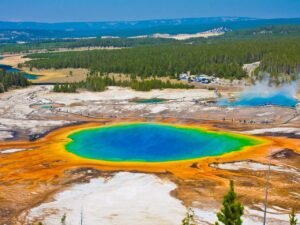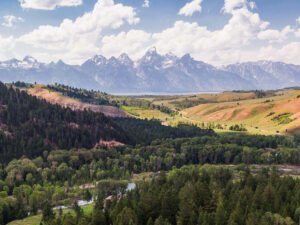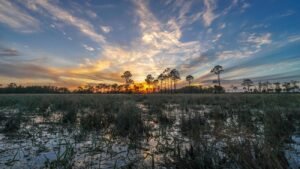These wildlife sanctuaries are special places where nature is protected. They are full of beautiful landscapes and different kinds of plants and animals. Alaska’s coasts are wild and Florida’s marshes are warm and humid, so these places are ideal for exploring and seeing wildlife. You can see grizzly bears in Yellowstone or alligators in the Everglades if you enjoy nature. These top 10 American wildlife sanctuaries are amazing if you enjoy quiet places. Denali offers hikes in tall mountains, and Okefenokee offers kayaking through swamps. These sanctuaries are also great places to take photos and learn more about nature. In some of the most beautiful places on earth, America’s wildlife sanctuaries offer unforgettable experiences wherever you go.

Yellowstone National Park, Wyoming:
Yellowstone National Park: Now, this is the Rutland Line, and Yellowstone National Park established in 1872, formed not only in the first National Park in America but protected throughout the world. Over 2 million acres, it is most famous for its geothermal activity, particularly the world famous Old Faithful geyser and the bright blue and orange Grand Prismatic Spring. But it’s the variety of wildlife in the park that really upholds it. It is home to an incredibly diverse wildlife population; which includes bison, elk, grizzly bears, wolves and bald eagles freely roam the land where mountains, forests and thermal basins coexist. With an abundance of grounds, trails, drives, and backcountry campsites, visitors are able to explore the park more intimately and see for themselves the natural beauty that Ricketts Glenn State Park offers on this extensive network of trails.

Everglades National Park, Florida:
Everglades National Park in the wetlands of southern Florida, home to the famous River of Grass, is an International Biosphere Reserve and World Heritage Site. Encompassing more than 1.5 million acres, this large tract of subtropical wilderness features sawgrass marshes, mangrove forests, and estuarine environments. The warm waters have become especially important in recent colder years, as temperatures here have surged-and the waters have become crucial escape hatches for at-risk wildlife like the endangered American crocodile, protected West Indian manatee and rare Florida panther as other refuges are sealed off due to low water levels. Your views depending on riding an airboat, Kayak, Mokoros, Kettle holes that have been drained to make swamp trails, or you will see alligators lying lazily in mudbanks, great blue herons stalking shallow waters and the chorus of birdcalls reverberate through mangroves.

Denali National Park and Preserve, Alaska:
At the heart of the Alaskan interior, Denali National Park and Preserve is all about extremes. At the center, Denali at 20,310 on top of the biggest peak in North America. Its 6 million acres include grizzly bears, moose, caribou, Dall sheep and an increasing variety of alpine flora. During your stay at Denali, you can hop onto the shuttle buses on Denali Park Road, a winding roadway through tundra and taiga providing you with some of the clearest views of the mountain, as well as opportunities to get up close and personal with the wildlife.

Great Smoky Mountains National Park, Tennessee/North Carolina:
Great Smoky Mountains, straddling the border between Tennessee and North Carolina, is known for dense mist enveloping its lush peaks, old growth forests and diverse animal life. At this UNESCO World Heritage Site you can encounter black bears, white-tailed deer, elk, and more than 200 avian species. Travelers can access panoramic overlooks and backcountry trailheads to remote waterfalls and historic homesteads from a series of scenic drives including Newfound Gap Road and Clingmans Dome Road. In addition to its natural wonder, the park is steeped in history, complete with preserved Appalachian log cabins and Cherokee artifacts.

Grand Teton National Park, Wyoming:
This one is slightly more like it for our American readers, with Grand Teton National Park delivering craggy summits, alpine lakes and the largest land animal that weighs less than a Volkswagen, all next door to Yellowstone. South of Grand Teton National Park in northwestern Wyoming, the Jackson Hole valley floor has some of the most stunning mountain views you’ll ever see, while the massively impressive Teton Range across the way just to the east offers countless outdoor activities. Walk through fields ablaze with wildflowers, kayak on serene lakes, and see wildlife at iconic attractions like moose, elk, bison, and bald eagles. Starting with Grand Teton which is the perfect postcard of the harsh and wild American West, this site is also a favorite with photographers, so beauty and serenity were both key factors to make the list.

Okefenokee National Wildlife Refuge, Georgia/Florida:
One of America’s largest intact freshwater ecosystems, the Okefenokee National Wildlife Refuge in the swampy lowland along the Georgia-Florida line, clearly makes the “good” list. This vast tract of swamps, prairies, and pine forests provides habitat for a variety of wildlife in the state, including alligators, black bears, river otters, and more than 200 species of birds. The refuge can be visited by paddling its water trails, hiking its elevated boardwalk paths, or enjoying guided boat tours. With the refuge’s serene beauty and diverse wildlife it truly is an extraordinary place to visit and take a step back and connect with nature in its rawest and most remote state.

Channel Islands National Park, California:
CA: Southern California The Channel Islands are a cluster of five rugged islands and their surrounding waters off the coast of Southern California. Channel Islands National Park is one of the most wonderful parks out there which is well especially the wonderful marine biodiversity which is endemic and does not exist anywhere else on earth. Guests can kayak through sea caves, snorkel in kelp forests full of wildlife, and hike on high cliff trails with distant sights of the sea. Preserving life on the islands, including seals, sea lions, dolphins, and the cute little island fox, it’s a wildlife-lover’s and outdoor-enthusiast’s dream.

Aransas National Wildlife Refuge, Texas:
Aransas National Wildlife Refuge on the central Texas Gulf Coast, shelters up to half of the species Estevan named in his diary…though, also the largest concentration of the endangered whooping crane. Bird species present in these habitats include waterfowl, shorebirds, raptors; oaks are present within the Prairie, Marshes, Oak Woodlands. In the fall and winter many birdwatchers descend on Aransas to see the huge whooping cranes feeding and roosting among the refuge’s wetlands. Trailroutes and a viewing area provide bird-watching, photography and some contemplative experiences in this maritime wildland.

Glacier Bay National Park and Preserve, Alaska:
Listen to this story on rare-earth and Environment Glacier Bay National Park and Preserve, located in southeastern Alaska, is home to stunning vistas and natural landmarks. Located in Alaska, this UNSECO World Heritage Site includes a landscape of high mountains, icefields, and glaciers, bears, seals, humpback whales and sea otters as well as archaeological sites. Glacier Bay visitors can sail among icebergs, kayak through fjords chiseled out by glaciers and hike wooded rainforest trails. Humpback whales, sea otters, brown bears, and mountain goats inhabit the park, making it a haven for wildlife lovers, and a hotspot for outdoor enthusiasts.

Big Cypress National Preserve, Florida:
Big Cypress National Preserve, located adjacent to Everglades National Park, offers a wet wilderness environment of cypress swamps, hardwood hammocks, and pine forests. This is prime habitat for the protected Florida panther and several other animal and bird species including black bear, alligator, river otter, and many nesting bird species. A scenic loop road, that takes visitors through the mangrove wetlands at the north end of Lake Trafford, is great for wildlife viewing and photography. Miles of hiking trails offer access to secret ponds and ancient Cypress trees that reveal a different natual Florida.
In Conclusion:
Each of them is a peek into the natural history of America, its habitat of diverse land and both the flora and fauna, preserved in wide, wild sweeps units – – like the Seal River Wildlife Management Refuge manages more than 3.14 million acres. From the untamed wilds of Alaska to the subtropical marshes of Florida to the grand mountains of the West, these refuges are steeped in experiences that are as rewarding and inspirational as they are refreshingly wild. Start planning your next adventure to one of these amazing places, and discover for yourself why wildlife refuges in America are ranked among the premier refuges in the world.

IPTV in USA has a new favorite—iptvusalive.com. Thanks for the excellent service!